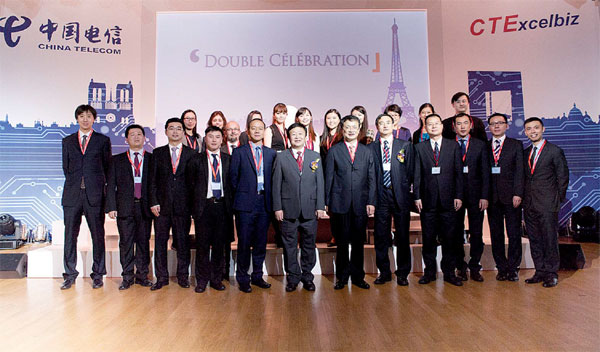Earthquake opened door for telecom giant
When damage to undersea cables cut service to Europe, partnership followed
In December 2006, the Hengchun earthquake off the south coast of Taiwan disrupted five submarine cables, cutting off the internet connection between Europe and Asia. Keen to keep its customers connected, British Telecom asked China Telecom for help.
"BT asked us to provide connections between London and Hong Kong within a week, and we only took half of that time," says Charlie Cao, managing director of China Telecom Europe.
China Telecom was able to provide BT with this service thanks to its extensive terrestrial and submarine cable networks linking Europe with Asia. When natural disasters like earthquakes affect cables, data transfer can still be achieved by rerouting it.
|
China Telecom's team at the opening of the company's Paris office in 2013. Provided to China Daily |
During the Hengchun earthquake, China Telecom's trans-Russian network was not affected, which made the service for BT possible.
"We have a higher numbers of cables compared with our Chinese competitors and we also provide efficient, direct and flexible services when transferring data across countries through these cables," says Cao.
The BT partnership in 2006 was one of China Telecom's first tasks in Europe, as the company established a European footprint by setting up a subsidiary in London that year.

With a decade of history in Europe under its belt, China Telecom is already a networking supplier to most major European telecommunications giants, including British Telecom, Vodafone, Telefonica, Deutsche Telekom and Orange.
China Telecom's history goes back to 1994, when the government established a company in Beijing that owned and controlled all public telecommunications, including mobile, fixed-line and postal services.
Over the years China Telecom underwent a series of changes and restructuring, the most significant of which was in 2000, which led to the establishment of the company China Telecom Corp as it is known today.
China Telecom has been listed on the Hong Kong and New York City stock exchanges since 2002.
In 2000, China Telecom also started to expand overseas by establishing a representative office in the US.
Over the years it expanded overseas, mainly across Europe, the Americas, Africa and the Middle East.
In 2012, a new company called China Telecom Global was established. In an effort to better integrate its resources, all of the company's overseas offices are integrated into China Telecom Global, which is headquartered in Hong Kong.

China Telecom's European expansion has grown rapidly since 2006 and now the company has subsidiaries across countries in Europe, including in Germany, France, Russia, Belarus and Turkey. It also has representative offices in a handful or other countries, including Benelux, Italy, Poland, Czech Republic, Portugal, Spain and Hungary.
Its equipment is installed in a half-dozen additional cities to facilitate communication, including Helsinki, Stockholm, Milan, Madrid and Istanbul.
"Geography is a key advantage we enjoy," Cao says.
To connect between Europe and Asia, ground-based cables need to go through China, Kazakhstan, Mongolia or Russia; therefore China Telecom's headquarters location in China gives it an advantage over Western telecommunications firms in rolling out such cables.
Compared with terrestrial cables, submarine cables are more prone to disruptions, and are more difficult to repair when they are broken.
China Telecom's European expansion plays a supportive role for Chinese companies in Europe, as these firms often need to send data back to their headquarters at very fast speeds or hold video conferences with colleagues in China or other international offices. Its corporate clients are now spread across industries including finance, manufacturing, retail, gaming and high technology firms.
"Once they are connected onto our network, they can enjoy global communication across more than 60 data points and 33 cables globally," Cao says.
China Telecom is also now increasingly providing corporate services to Western companies, especially those requiring communication with China.
"Before our entrance into Europe, many of these corporate clients were served by Western carriers. Most major Western carriers entered the Chinese market by partnering with Chinese firms like us, but now that we're going global we are competing with them to expand our client base," says Cao.
The roll-out of China Telecom's cable infrastructure between Asia and Europe means many Western clients can enjoy the same services. Compared with Western telecommunications firms, the company has "more flexibility and quicker responses to clients' needs on a regular basis", Cao says.
In addition to serving corporate clients, China Telecom also launched a dual-number SIM card service in 2012, targeting retail clients, who are mostly business travelers or overseas Chinese.

Known as CTExcelBiz, this SIM card allows clients in the UK and Europe to make and receive calls with local numbers and Chinese numbers at local service rates. Currently there are 20,000 such cards in use in the UK, and an additional 20,000 in France.
The SIM card issued in France has two versions, one focusing on usage in France, and the second on customers frequently traveling to other continental European countries by providing cheap roaming services.
In addition to facilitating calls, the card also supports mobile payment activities using Alipay and Wechat Pay, as both apps can only support Chinese mobile phone numbers.
With a decade of history in the UK, China Telecom has also developed a unique corporate culture, characterized by placing strong emphasis on customer trust, thinking from the customer's perspective and respect for contracts.
"We try to build strong trust with our customers. We are honest when doing business with them. We do not over-emphasize our abilities and we do not make promises for things we cannot deliver," says Cao of China Telecom.
Thinking from the customer's perspective often does not necessarily mean providing them with the most expensive package of products, Cao says.
"If we realize they do not require a service package with such great speed or bandwidth, we will recommend a more cost-efficient package that will still satisfy their needs."
Looking to the future, Cao says his team will increase geographical reach with its services, broaden service range and venture into new business areas like cloud technology and smart technology.
"Currently we've established quite a presence in Western European countries like the UK, France and Germany, but we still see many more opportunities in the Scandinavian countries, in Portugal, Spain and Turkey," Cao says.
Cao says his team would also like to broaden its services for corporate clients, and in particular supply ICT (integration communication technology) systems to Chinese companies coming to the UK and Europe. ICT systems refer to a package of telecommunications services that satisfy a Chinese company's needs in a comprehensive way.
"In addition, we would like to explore opportunities to provide cloud and smart cities technologies. For example, a lot of cloud technology may encounter firewall challenges in China, and we could contribute toward overcoming these technical barriers," says Cao.
His team is already exploring cloud technology opportunities in partnership with Alibaba Cloud, Google, Amazon and Microsoft.
cecily.liu@mail.chinadailyuk.com
(China Daily European Weekly 12/16/2016 page30)























